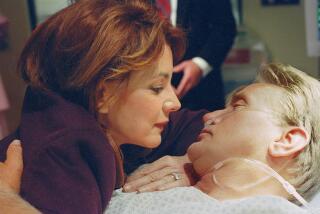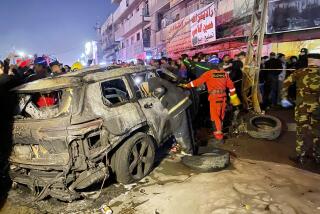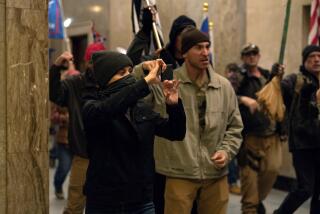ON TARGET
- Share via
BAGHDAD — In the cross hairs of a gunner’s periscope, a mural of Saddam Hussein came into focus on an arch spanning the Jumhuriya bridge over the Tigris River.
Maj. Mark Jewell aimed a laser just beyond Hussein’s nose and shot it onto a 15-story building on the opposite riverbank. Crouching in the cramped track commander’s seat of a Bradley fighting vehicle, Jewell was marking a spot on the tower for an F-15 fighter pilot to launch a laser-guided missile.
All Tuesday morning, Iraqi soldiers in or around the building had fired across the Tigris at American tanks and soldiers on the river’s west bank. U.S. intelligence officers had determined that Iraq’s military intelligence network had taken refuge in the office tower after an American onslaught the day before drove them across the Tigris.
“Three minutes, men!” Jewell screamed to his six-man crew in a Bradley outfitted both to fight and to call in airstrikes, even while in combat. “We’re taking this building down!”
The crewmen of Lightning 28 locked and loaded their rifles, looking lonely and exposed against the hulking Bradley in the middle of the deserted bridge. They were eager to see the Iraqis driven from the tower, having fought through machine gun and rocket-propelled grenade fire all morning just to reach the bridge.
Throughout the battle, the gunners blasted away with the Bradley’s guns while four crewmen in the Bradley’s hull shouted frantically into radios, trying to arrange airstrikes.
In the commander’s perch, Jewell was pumping out 7.62-mm rounds from the Bradley’s powerful machine gun. The projectiles tore through Iraqi bunkers, where soldiers were dug in and opening up on the convoy.
In the Bradley’s hull, Capt. David Cooper was talking and listening on two radios at the same time. In his lap, bouncing and pitching as the Bradley rumbled through smoke-filled streets, was a notebook on which Cooper scribbled grid coordinates coming through his headset.
At the same time, he shouted orders to Cpl. Trevor Havens, who was on two other radio networks, while also holding an automatic rifle through a gun port in the Bradley’s rear steel door. Lt. Matthew Hanks scrambled back and forth between the hull and the upper deck.
They were so intent on their work that they didn’t flinch when rounds exploded outside or when the Abrams tanks in their convoy erupted with cannon fire. From time to time, they glanced through 3-inch-high slits at swirls of smoke from scorched Iraqi troop trucks and machine gun positions.
Through another headset, Sgt. Dennis Parks helped monitor all five “nets” -- military networks -- and helped Cooper stay in touch with Jewell up in the commander’s seat. At times, Parks shouted over the gun and rocket fire to the driver, Spc. Richard Sharp, or the gunner, Sgt. Walter Daniel.
Somehow, through the chaos and through the black smoke that drifted into the tight hull, aircraft were summoned, directed to targets and guided through the process until their bombs or missiles were launched.
The process involved men from three branches of the American military and pilots from two nations. Jewell, Cooper, Havens and Parks are U.S. Marines on a special air liaison detachment with an armored battalion of the Army’s 3rd Infantry Division. Tuesday, they called in airstrikes from the U.S. Air Force and Britain’s Royal Air Force.
During a brief lull in the battle, the crew pitched in with medical and humanitarian work. Spotting an elderly man with his left arm shredded by shrapnel, they radioed for U.S. medics and tossed out bandages for the man’s friends to use to stop his bleeding.
A crowd of civilians cheered the Americans and offered bottled water. “USA! USA!” they chanted. And: “Saddam, no!”
Havens was showered with cool water by a man who bowed and began to gently wash Havens’ face.
“I guess that was some kind of special welcome they give people,” Havens said, shrugging.
Minutes after the Bradley moved on, a rocket screamed in behind it, smashing into a concrete wall a few yards away.
By the time the team’s armored column had fought its way to the Jumhuriya bridge, another armored column had destroyed an Iraqi unit that had mounted a final stand at a park at the foot of the bridge. The sandbags on top of the Iraqi bunkers had been pulverized by tank fire, exposing poorly constructed wood beams across the top. Dead soldiers -- at least 14, said the unit’s commander, Capt. Phillip Wolford -- were sprawled in the park beneath palm trees sheared off by tank rounds.
A phalanx of tanks and Bradleys was gathered at the foot of the bridge, their barrels pointed across the Tigris at the 15-story tower. The crew of Lightning 28 drove its Bradley halfway across the bridge, in no-man’s land beside a riverside apartment complex that had burst into flames.
There, they made the final preparations for airstrikes on the tower. Cooper, the battalion air officer, had already gone through the intricate and trying process of getting the target selected, approved and assigned, then pulling aircraft off “the stack” of close air support -- “kind of a big parking lot in the sky,” he said -- to carry out the mission.
Because of concern for civilian casualties in the dense urban setting -- and the proximity of U.S. Marines to the southeast who were pinning Iraqi forces against the Tigris -- it took nearly four hours for the target to be approved. The crew sat in the moist, sweltering heat of the hull, alternately bored or craning their necks at the sound of sniper rounds.
Finally, Cooper arranged for two British Tornado fighter planes to each drop a 1,000-pound Mark 83 Joint Direct Attack Munitions, a sophisticated bomb guided by a global positioning system. Bouncing in the hull during the battle, Cooper had converted GPS grids to longitude and latitude required to initially program the bombs.
In the track commander’s seat, Jewell spoke by radio to the pilot. Jewell was the forward air controller. He had trouble at first with the pilot’s accent -- “He’s British, after all,” Jewell said later -- but the two found a common language.
The first bomb tore a black gash into the tan face of the tower, unleashing a spiral of gray smoke. The second hit lower, with equal effect.
“Outstanding hits!” said a voice on the radio.
For the second series of strikes -- six missiles from three F-15s called in by Cooper -- Jewell fired a laser to mark targets for each missile. Minutes before the first was launched, Jewell alerted his crew. They climbed outside to watch; two pulled out pocket cameras to capture the moment.
The pilots were wary. Twice Tuesday morning, U.S. warplanes had been hit by antiaircraft fire. One plane crashed at the international airport; the pilots of both planes returned safely, according to Cooper.
A gray F-15 roared in, followed by a low grumble, and then banked over the river, barely visible against the black curtain of smoke hanging over Baghdad. A bright flash burst from under the wing.
Seconds later, a black streak slammed into the building, unleashing a ball of orange flame and white smoke. Four other missiles followed, tearing out four new gashes. A fifth misfired.
Each hit brought a roar from the crews assembled at the foot of the bridge. In the middle of the span, Parks let out a soft curse. “Oh, man, awesome!” he said.
There was no way to determine whether any Iraqi military were still in the building. Nor was it possible to determine how many civilians, if any, were in or around the building.
All Cooper could do was get on the radio and give a preliminary BDA -- a battle damage assessment.
“Good effects on entire building,” he said into the microphone. “Building still standing, but I guarantee you there’s nothing left inside.”
More to Read
Sign up for Essential California
The most important California stories and recommendations in your inbox every morning.
You may occasionally receive promotional content from the Los Angeles Times.














